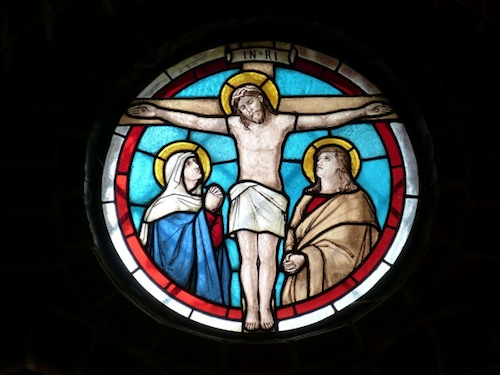We run our website the way we wished the whole internet worked: we provide high quality original content with no ads. We are funded solely by your direct support. Please consider supporting this project.

God’s Love is Cruciform
Paul instructs us in what it means to follow Jesus, when he stated, “Follow God’s example, therefore, as dearly loved children and walk in the way of love, just as Christ loved us and gave himself up for us as a fragrant offering and sacrifice to God (Eph 5:1-2). Here Paul defines what it means to imitate God and to “live a life of love” not merely by pointing us to Jesus but by specifying that we are to follow the example of Christ who “loved us and gave himself up for us…” (Eph. 5:1-2, NIV, emphasis added). Paul virtually equates “following (mimētēs) God” (which could be translated as “imitating God”) with living “a life of love, just as Christ loved us and gave himself up for us.”
Several verses later Paul applies this cruciform understanding of love to husbands when he tells them to “love your wives, just as Christ loved the church and gave himself up for her” (Eph. 5:25). While everything Jesus did reflected God’s love, it’s clear that Paul regarded the cross to be the ultimate expression of this love.
Reflecting this same perspective, Paul elsewhere declares that God’s love for us is demonstrated not merely in the fact that Christ became a human and lived a life of self-sacrificial service to others, as remarkable as these things are. It is rather most powerfully demonstrated in the fact that “[w]hile we were yet sinners, Christ died for us” (Rom. 5:8). So too, Paul fleshes out what it looks like for the Philippians to love one another by instructing them to have “the same attitude of mind Christ Jesus had” (Phil. 2:5). This attitude was displayed when Jesus set aside his divine prerogatives, “made himself nothing,” and “humbled himself by becoming obedient to death – even death on a cross” (Phil. 2:6-9).
So too, when Paul explains why he and his colleagues appear to some to be “out of [their] mind” (2 Cor. 5:13) because of the sacrifices they make as “ambassadors of Christ” (2 Cor. 5:20), he declares, “Christ’s love compels us” (2 Cor. 5:14). He then elaborates on this love by appealing to the cross, explaining that Christ “died for all” so that “those who live should no longer live for themselves but for him who died for them and was raised again” (2 Cor. 5:15).
The cross is clearly the definitive expression of Christ’s love and thus the criteria by which his followers must measure their love. It’s no surprise, therefore, when Paul later challenges the Corinthians to prove their love by sacrificially giving to brothers and sisters in need (2 Cor. 8: 7-8, 24). “Cruciformity” lies at the heart of Paul’s understanding of God, salvation and the kingdom life. More could be said (as I have two chapters on this in Crucifixion of the Warrior God), but I believe this suffices to demonstrate that the love that God eternally is, as revealed in Jesus Christ, and the love that is to characterize all who are “children of the most High,” is cruciform in nature.
Photo via VisualHunt.com
Category: General
Tags: Crucifixion of the Warrior God, Cruciform Theology, God is Love, God's Love
Topics: Attributes and Character
Related Reading

Podcast: How Does God’s Wrath Fit within a Cruciform Theology?
Greg considers God’s wrath. http://traffic.libsyn.com/askgregboyd/Episode_0390.mp3

God’s Non-Violent Ideal in the OT
While God condescended to working within the violent-prone, fallen framework of his people in the Old Testament—as I argue in Crucifixion of the Warrior God—the OT is also full of references to how God worked to preserve his non-violent ideal as much as possible. He did this by continually reminding his people not to place…

Podcast: Greg Introduces His Cruciform Hermeneutic at the CrossVision Conference and Dialogues with Rachel Held Evans
Greg Introduces His Cruciform Hermeneutic at the CrossVision Conference and Dialogues with Rachel Held Evans. http://traffic.libsyn.com/askgregboyd/Episode_0240.mp3

Redefining Transcendence
God is transcendent, which basically means that God is “other” than creation. The problem is that classical thinking about God’s “otherness” has been limited to what reason can discern about God. As a result, all that can be said about his transcendence is what God is not. We are thus unable to acquire a positive…

Podcast: Overflow Episode 1 — Dust, Flashlights, and Heathens
Dan and Brianna tackle some tough questions: —Is it okay for Christians to be cremated? —How can we preach from the OT with authority? —What should a Christian academic know in a secular school? http://traffic.libsyn.com/askgregboyd/Episode_0320_overflow_1.mp3

A Cruciform Magic Eye
In this post I’d like to share the story of how I came upon the thesis I’m defending in the book I’ve been working on for the last four years entitled The Crucifixion of the Warrior God: A Cruciform Theological Interpretation of the Old Testament’s Violent Divine Portraits. It’s a much longer post than usual,…
